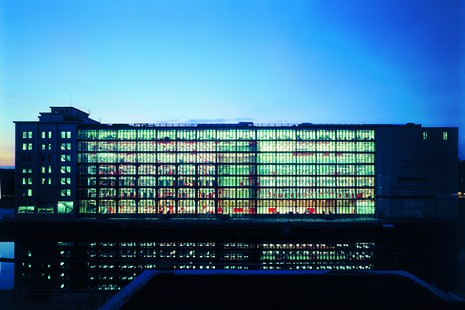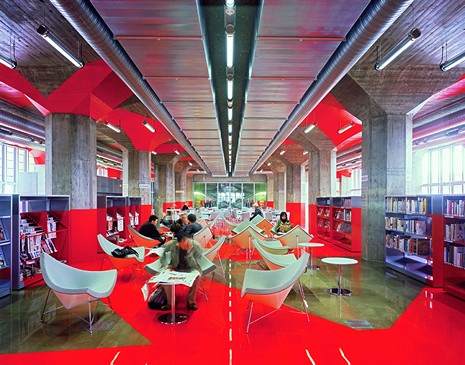Description
Located in the heart of Strasbourg, the home of Johannes Gutenberg and one of the earliest centers of printing, the Médiathèque André Malraux is the largest library in eastern France. Designed by Jean Marc Ibos and Myrto Vitart, this project is one of several planned for the conversion of the former industrial port, Bassin d’Austerlitz, to one of the city’s “cultural islands”. In keeping with the objectives of the Société d’Aménagement et d’Equipement de la Région de Strasbourg (S.E.R.S.) “to preserve existing buildings and develop them”, the new library is exemplary in its adaptive reuse of a decommissioned grain silo and warehouse.
The library site on the long and narrow peninsula next to the Bassin d’Austerlitz is part of the industrial docks of the Seegmuller pier. A former grain silo and warehouse built in the 1930s, its conversion to a library included both renovation and extension. The interior of the ten-story silo was stripped of its grain storage cells but its structure and full height of 47 m were retained as the entrance atrium for the library, a dramatic space that each floor overlooks. In the adjacent warehouse with its low floor-to-ceiling heights, the structural frame of massive concrete columns and floors was retained and even extended in a small addition on the east side. The long facades were removed and replaced with a metal and glass skin that allows light to penetrate the low and dark floor plates. A series of exterior metal stairs were added on the north side providing a rhythm to the glazed facade along the waterway. In explaining their work, the architects stated that“… everything obeys the logic of the waterway: linearity of embankments, extent of the pier, alignment of trees. Even the buildings, set in profile from one end the other, are in perfect continuity parallel to the embankments, with their silos, like prows, vertically punctuating the extremities.”
The presence of the industrial past, most notably the elements of raw concrete, the structural grid, the repetitive bays and the linear form, is juxtaposed with the present through the use of color and graphics. Old and new are visibly intertwined in the interior by the application of a bold red color, painted directly on the concrete traversing the length of the building in rectilinear planes and linear shards. Moving from the floor plane to the column capitals, onto the vertical wall surfaces and along the expanse of low ceilings, the ribbon of color that begins on the surface of the entry plaza serves as a device that guides the user through this 11,800 m² library, simultaneously breaking and reinforcing its linearity. The furniture, too, complements this device of color through a palpable plasticity in the same shade of red.
The signage and wayfinding for this library of “8 departments over 6 levels … 160,000 documents, … 20 kilometers of shelves” and 1,000 seats are the work of Intégral Ruedi Baur et Associés. Using texts “escaped” from books to “punctuate the space … and reveal the materials”, the signage is incorporated into the red ribbon; etched on the floor, moving up the columns, onto the walls and even the facade of the painted silo itself. This use of text and text fragments creates an ambiguity, blurring the line between function and art. At night, the glass facades dematerialize allowing for a view of the library and revealing it as a masterful fusing of past and present.
Drawings
Second floor
Third floor
Longitudinal section
Cross sections
East elevation
West elevation
Photos

Night view of the new glazed facade on the former warehouse

The use of bold color, furniture and graphic design integrates the existing concrete structure with the new library program
Originally published in: Nolan Lushington, Wolfgang Rudorf, Liliane Wong, Libraries: A Design Manual, Birkhäuser, 2016.